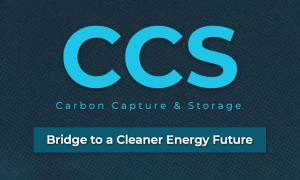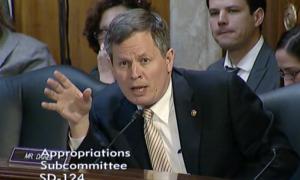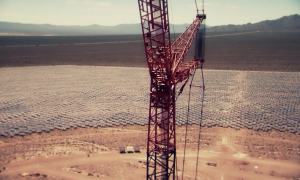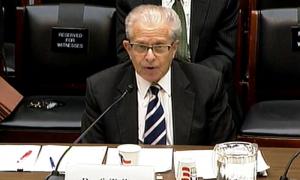“People know what a windmill is,
they know what a solar panel is;
they don’t know what CCS is.
They’ve never seen it.”
— Julio Friedmann, CEO, Carbon Wrangler
Union aligns with advocacy groups to promote CCS
A NEW IBB-PRODUCED video documentary “CCS: Bridge to a Cleaner Energy Future,” breaks ground in our quest to bring carbon capture and storage into mainstream conversation and to promote its development and deployment. The video and its companion website (www.cleanerfutureccs.org) offer a much-needed platform for viewers to learn about CCS and advocate for it around the world.
In producing the video, we aligned with topic expert and support organizations that — like our union — see CCS as essential to heading off the worst effects of climate change by capturing carbon dioxide emissions and storing CO2 safely underground or using it in commercial products.
The documentary includes interviews with thought leaders and activists in this arena, including Julio Friedmann, CEO of Carbon Wrangler; Brad Page, CEO of the Global CCS Institute; Mike Monea, President and CEO of the International CCS Knowledge Centre; Ian MacGregor, Chairman and CEO of North West Refining, Inc.; Sandra Odendahl, CEO, CMC Research Institutes; Beth Hardy, Vice-President for Strategy and Stakeholder Relations, International CCS Knowledge Centre; Tim Wiwchar, Athabasca Oil Sands Project (Shell Quest); Erik Nickel, Director of Operations, Petroleum Technology Research Centre; and Alison Cartier, Marketing and Communications Manager, Inventys Inc.
Two of our International reps — Cory Channon and Richard MacIntosh, who are engaged in advocating for CCS, especially in Canada — are among those featured.
Promoting CCS (often used interchangeably with CCUS, for carbon capture, use and storage) has been a priority of our union for more than a decade. In the United States, our Department of Government Affairs lobbies for legislation and regulations favorable to CCS funding and development, among other responsibilities. DGA Director Cecile Conroy carries on this work by forging alliances with like-minded labor unions, companies and coalitions such as the Carbon Utilization Research Council (CURC).
Through these relationships, we strengthen our voice and our role in the global effort to address climate change while also building the potential for an extraordinary amount of work for our members and other trades.
Educating the public about CCS
ONE OF THE biggest challenges we and other CCS proponents face is educating the general public about what CCS is, how it works and why we should all care.
That is exactly what our video is designed to do. It is intended for a general audience that may or may not understand the significance of global warming or how CCS can help avoid its worst effects. It also addresses the need for government support as well as the importance of preserving good jobs and creating more work opportunities for healthy communities through CCS-related projects.
As Julio Friedmann says in the video, “People know what a windmill is, they know what a solar panel is; they don’t know what CCS is. They’ve never seen it.”
We need to change that information deficit. We want this video to be shared broadly around the world. The more people are aware of CCS and its benefits, the more quickly we can generate support for it — and the more quickly CCS technologies can be implemented.
The need for CCS has never been more urgent
HUMANITY IS RUNNING out of time to avoid catastrophic impacts of global warming, including rising sea levels; species extinction; the loss of sea ice and coral reefs; and more frequent and more severe floods, droughts and wildfires. That’s the message presented by the Intergovernmental Panel on Climate Change in a new report issued October 8.
“At the end of the day, if what you care about is our planet and our home, then really you want to embrace everything that can get this problem solved.”
— Brad Page, CEO, Global CCS Institute
According to the IPCC, which is the leading international body on assessing climate change, we have just 12 years to prevent global warming levels that will be disastrous. The report (at www.ipcc.ch/report/sr15/) says unprecedented changes must be made across global economies, especially in the production and use of energy. And, alarmingly, the IPCC is doubtful that nations around the world have the will to make those changes.
The federal government’s Fourth National Climate Assessment, released November 23 to the White House and Congress, echoes the dire warnings expressed by the IPCC. (See nca2018.globalchange.gov.)
Unfortunately, President Trump has been skeptical of human-caused climate change. He pulled the U.S. out of the Paris climate accord shortly after taking office, drawing widespread criticism for not taking the dangers seriously. While the Boilermakers do support his positions on several key energy-related priorities — especially pertaining to fossil fuels — we maintain that withdrawing from the Paris accord was a mistake, as the United States must remain engaged globally. Climate change is, after all, a global problem that requires a global solution.
We need leadership from the White House and Congress to rapidly advance CCS. The recent tax incentive regarding CO2 capture, storage and use, 45Q, was a good start — but just that, a start. We need strong, ongoing advocacy at the highest levels of government.
We know that CCS has the potential to positively mitigate global warming by removing CO2 from power generation and other industrial emissions — and even directly from the air. Scaling up CCS in North America and around the world will take an enormous investment. But that investment has to be weighed against the extreme cost of global climate disasters and irreversible damage to our planet.
Moreover, we know that capturing and storing carbon dioxide works. Our members have been a part of such projects: at the Shell Quest upgrader in the Canadian oil sands, at the Sturgeon Refinery in Alberta and at SaskPower’s Boundary Dam coal-fired plant in Manitoba.
In the United States, NET Power’s new Allam Cycle technology promises zero emission, while NRG Energy’s Petra Nova plant is capturing 90 percent of CO2 at a coal-fired plant near Houston.
Of course, just as with any emerging technology, there are hurdles. (Consider, for example, the first computers, which were enormous and expensive beasts of machines!) The history of technological evolution tells us that the more we apply new technology, the more repeatable and less costly it becomes. CSS Knowledge Centre’s Mike Monea describes the early CCS applications as “first movers that are demonstrating the path for cost reduction.” Monea says, “Thousands of plants are needed to meet global GHG (greenhouse gas) reduction goals.”
Major investments by companies, substantial government subsidies and continuous public relations efforts to build public support have been necessary for the successful application of wind and solar globally. We need those same components to make CCS equally successful.
Let’s get the word out on CCS
I ENCOURAGE ALL our members to take an interest in promoting CCS. Visit the cleanerfutureccs.org website. Share the site and our video with family, friends and acquaintances. Write a letter to your legislators (there’s a form letter on the site). We need everyone to do his or her part in advocating for CCS.
The coalitions we build are critical to moving CCS forward, but so is the grass-roots effort of individuals. We must build the case for CCS as soon as possible, especially considering the dire warnings of the IPCC and the U.S. Fourth National Climate Assessment.
A quote from Brad Page in the video, I think, states the case for CCS very well: “At the end of the day, if what you care about is our planet and our home, then really you want to embrace everything that can get this problem solved.”




















0 Comments